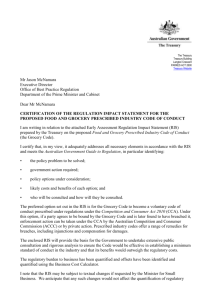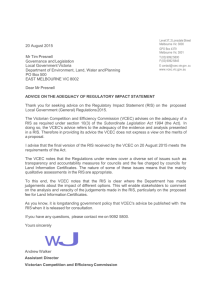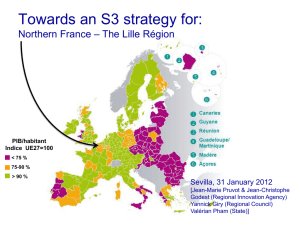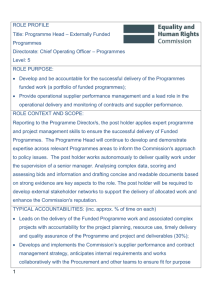Commonwealth Programmes - Department of the Prime Minister and
advertisement
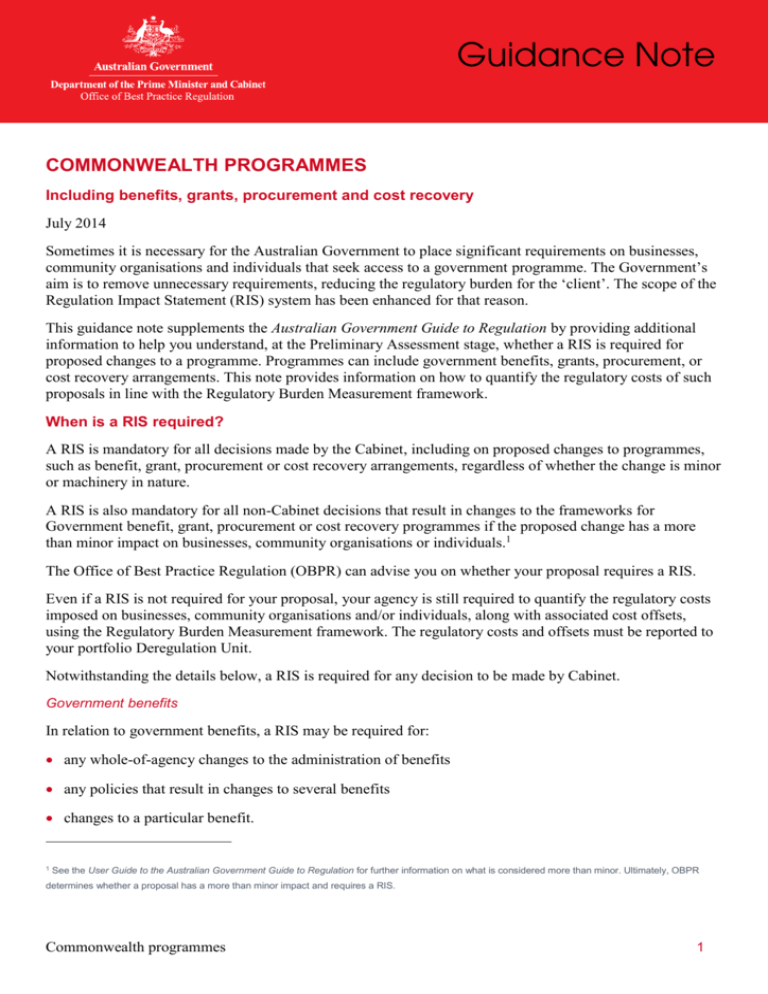
COMMONWEALTH PROGRAMMES Including benefits, grants, procurement and cost recovery July 2014 Sometimes it is necessary for the Australian Government to place significant requirements on businesses, community organisations and individuals that seek access to a government programme. The Government’s aim is to remove unnecessary requirements, reducing the regulatory burden for the ‘client’. The scope of the Regulation Impact Statement (RIS) system has been enhanced for that reason. This guidance note supplements the Australian Government Guide to Regulation by providing additional information to help you understand, at the Preliminary Assessment stage, whether a RIS is required for proposed changes to a programme. Programmes can include government benefits, grants, procurement, or cost recovery arrangements. This note provides information on how to quantify the regulatory costs of such proposals in line with the Regulatory Burden Measurement framework. When is a RIS required? A RIS is mandatory for all decisions made by the Cabinet, including on proposed changes to programmes, such as benefit, grant, procurement or cost recovery arrangements, regardless of whether the change is minor or machinery in nature. A RIS is also mandatory for all non-Cabinet decisions that result in changes to the frameworks for Government benefit, grant, procurement or cost recovery programmes if the proposed change has a more than minor impact on businesses, community organisations or individuals.1 The Office of Best Practice Regulation (OBPR) can advise you on whether your proposal requires a RIS. Even if a RIS is not required for your proposal, your agency is still required to quantify the regulatory costs imposed on businesses, community organisations and/or individuals, along with associated cost offsets, using the Regulatory Burden Measurement framework. The regulatory costs and offsets must be reported to your portfolio Deregulation Unit. Notwithstanding the details below, a RIS is required for any decision to be made by Cabinet. Government benefits In relation to government benefits, a RIS may be required for: any whole-of-agency changes to the administration of benefits any policies that result in changes to several benefits changes to a particular benefit. 1 See the User Guide to the Australian Government Guide to Regulation for further information on what is considered more than minor. Ultimately, OBPR determines whether a proposal has a more than minor impact and requires a RIS. Commonwealth programmes 1 These changes require a RIS only if they have a more than minor impact on businesses, community organisations or individuals. RISs are not required for individual arrangements or ongoing activities under existing government benefits (for example, approving a new applicant within an established benefit programme). Grants In relation to grants (which are defined in the Commonwealth grants rules and guidelines), a RIS may be required for: any whole-of-government framework changes (such as the introduction of reporting requirements for grant recipients) any whole-of-agency changes in grants administration or substantial programme changes (such as the merging of several grant programmes). These changes require a RIS only if they have a more than minor impact on businesses, community organisations or individuals. It is unlikely that a single grant would have such an impact and require a RIS. RISs are not required for individual arrangements or ongoing activities under existing grant programmes (for example, approving a new applicant within an established grant programme). Procurement For procurement (which is defined in the Commonwealth procurement rules), a RIS may be required for changes to the Commonwealth procurement rules, guidance material or other legislation, and for policies that interact with the procurement framework to impose an additional burden on businesses. Changes need to have a more than minor impact on business to require a RIS. Specifically a RIS may be required for the introduction or removal of a procurement-connected policy, as defined by Department of Finance, that imposes or removes a burden on businesses contracted to provide goods or services to the Commonwealth, such as reporting on the composition of the organisation, internal policies of the organisation or compliance with legislation. The RIS requirements do not apply to the specific procurement activities of agencies (for example, the Department of the Prime Minister and Cabinet entering into a contract for the supply of technical skills training for its employees). Cost recovery For cost recovery (which is defined in the Australian Government cost recovery guidelines), a RIS may be required when agencies introduce new regulatory or quasi-regulatory requirements, such as: changes to the Government’s cost recovery framework that affect the non-government sector significant changes to the cost recovery model for a specific activity or group of activities. A RIS is required for changes to a cost recovery model, where the change has a more than minor impact on businesses, community organisations or individuals. A RIS may still be required even if the proposal is documented in a Cost Recovery Impact Statement. Commonwealth programmes 2 Eligibility criteria RIS requirements are not triggered by proposed changes to the criteria for participating in government programmes. For example: changes to eligibility requirements changes to assessment criteria for procurement processes, changes to conditions for participation. Quantifying regulatory costs This section explains how you should calculate regulatory costs for a government benefit, grant, procurement or cost recovery proposal under the Regulatory Burden Measurement framework. Frameworks Frameworks are defined broadly to include any regulatory or non-regulatory instruments that affect businesses, community organisations, individuals or any combination of them. They can include whole-of-government frameworks, whole-of-agency frameworks and frameworks for a particular group of measures. The impacts of any change in requirements imposed by a framework should be calculated by the agency responsible for the framework. For example, the impact on businesses and community organisations of the introduction of tools that standardise and/or streamline procurement or grants practices across the Australian Government would be calculated by the Department of Finance, which is responsible for the whole-of-government grants and procurement frameworks. Offsets for increases in regulatory costs are required. Usually, whole-of-government regulatory costs should be shared among agencies covered by the framework and the responsible policy entity. When costing frameworks, you should be cautious about what is costed at the framework level compared to what is costed for each programme, model or activity. In general, costs should be calculated at the framework level where the framework is prescriptive enough that a decision maker does not have material discretion in how to apply the requirements of the framework to the operation of the programme, model or activity. For example, the framework might require all programmes to demonstrate ‘value for money’. However, this requirement allows a significant level of discretion as to how to meet the requirement for particular programmes, and so should be costed at the programme level, not at the framework level. Programmes Interaction with government programmes, such as grant programmes, or access to government benefits has a regulatory cost. For example, a grant programme that pays $1,000 to a recipient but has a $10 compliance cost only provides a net benefit of $990 to the recipient. Even though the assistance provided by the programme may be greater than the compliance costs associated with the programme, the compliance costs must still be quantified and any increases in costs should be offset. In this example, the $10 compliance cost must be offset even if the recipient is still $990 ‘better off’. Commonwealth programmes 3 Changes to a programme that create or remove requirements over and above those prescribed by the relevant framework need to be costed by the department instigating the additional requirement. A framework could be that prescribed by Finance, a particular agency’s framework or even the framework of a particular programme area.2 Costings are not required for activities under an existing programme that are within the programme parameters. This could include individual grant funding agreements entered into, additional funding provided under an existing programme or ongoing activities under existing programmes. Changes to the administration of a programme can change the regulatory costs to businesses, community organisations or individuals, and this should be quantified. Improvements to the way a programme is administered (for example, simplifying the reporting and administration requirements associated with a grant) can be counted towards the red tape reduction target. Determining the population for use in regulatory cost calculations When determining regulatory costs for government programmes, the affected population includes the total number of business or individual applicants, whether they are successful or not. However, the population for determining ongoing regulatory costs associated with a programme includes only successful applicants. If a new programme is introduced, the regulatory costs for those individuals, businesses or community organisations that are likely to apply to access the programme should be quantified. If a programme is abolished, the regulatory cost savings for those individuals, businesses or community organisations that were previously applying and can no longer apply to access the programme should be quantified.3 When costing the abolition of a programme, consider whether the application costs for applicants should be quantified. In most cases, those costs would be considered sunk and should not be quantified. In these cases, only the ongoing compliance costs for the successful applicants in the programme should be quantified. For example, you would capture the reduction in costs from businesses that can no longer receive a grant and therefore do not need to lodge claims and keep records. If there is a change in the number of stakeholders accessing a programme as a result of an explicit new government decision, through a change in either the supply of places available in the programme or in the eligibility criteria to access the programme, the regulatory costs and savings for those individuals, businesses or community organisations that are likely to apply for the programme, as well as those who will now be successful, should be quantified.4 For example, if the number of individuals eligible for a visa decreases because of an explicit government decision, and so fewer individuals have to complete administrative requirements, this is costed as a regulatory saving. 2 The Commonwealth grants rules and guidelines do not impose any requirements on grant recipients. Therefore, most costs are calculated for the particular grant or grant programme. However, Finance’s procurement guidelines are more specific and allow limited discretion. Therefore, most costs imposed by agencies’ individual procurements are in line with the procurement guidelines and costings would be minimal. 3 It would be best if agencies separately identify these cost savings in their quarterly returns. 4 Costings are not required for demand-driven changes in eligibility (for example, a decrease in unemployment and the associated decrease in applications for unemployment benefits). Such regulatory costs would be measured in any stock of regulation processes. Commonwealth programmes 4 Under this option, the business-as-usual population is taken to be the total number of people accessing the programme before the expected change, including those applying and those who are successful. For example, if an agency proposes to tighten eligibility requirements and at the same time simplify forms, two different costings would need to be completed under this option: one for the decrease in people applying to access the programme and one for calculating the savings as a result of simplified forms. In this example, if 10,000 people were applying to access a programme with 5,000 places, and after the eligibility requirements are tightened to allow 4,000 places the number of people applying is expected to fall to 7,000, costings would need to be completed for the 3,000 people who are no longer applying and therefore no longer have to complete the administrative requirements as well as the 1,000 people who are no longer successful and therefore no longer need to meet the requirements. The business-as-usual population for quantifying regulatory costs of the simplified forms would then be based on the 7,000 people applying to the programme and the 4,000 successful applicants. Under this business-as-usual scenario, if a programme is abolished, the costings are conducted using the number of people accessing the programme before the change (that is, the number of people accessing the currently available programme). What regulatory costs should be included? You should use all the regulatory costs in the Regulatory Burden Measurement framework in your calculations, where those costs occur. Quantify both the regulatory costs associated with the application process and the post-application costs for successful applicants. As with all costings, you should take into account the business-as-usual costs for a normally efficient business or community organisation or a normally informed individual. Therefore, if it can be reasonably expected that businesses, individuals and community organisations should already hold particular information, these costs should not be included. Application and tendering costs The application costs for a programme or the tendering costs for a procurement process should be quantified. You should calculate them as the regulatory costs to all businesses, community organisations and individuals that apply or tender, whether the applications or tenders are successful or not. For programme-level costings, the costs should be calculated only if they are in addition to those already costed by broader frameworks. If it is unclear what the number of applicants/tenderers will be at the time of the RIS or regulatory costing, make an initial estimate based on the best available information. Provide final costs to the Office of Deregulation as part of the self-assessment process. This costing should include any up-front costs for stakeholders, such as discovery costs, but only where the cost could reasonably be expected to be a part of the programme. Those up-front costs should only be calculated for those who apply, so costs incurred by stakeholders to determine eligibility should not be included. Commonwealth programmes 5 Post-application costs For grant, benefit and cost recovery programmes, the regulatory costs imposed on successful stakeholders should be included. For example, if a grant to business requires quarterly reporting of activities undertaken, the costs associated with the reporting should be quantified for all those receiving the grant. For procurement, the regulatory costs imposed on the successful stakeholder to demonstrate compliance with a contract should be included. The costs imposed by the contract, such as providing the good or service, should not be included, but regulatory costs associated with demonstrating compliance with the contract (such as costs of quarterly progress updates) should be. This includes any post-application costs imposed by a framework and those imposed by the individual contract. For example, if the Department of Finance introduces a condition in the procurement rules requiring every non-government supplier that enters into an agreement with the Government to provide quarterly progress reports on the requirements outlined in the contract, that new condition must be costed. Mutual obligations Some mutual obligations are imposed on stakeholders in return for a benefit. A mutual obligation activity is a stakeholder behaviour that government policy aims to influence. For mutual obligations, the obligation itself should not be costed, but actions taken to demonstrate compliance with the obligation must be costed. For further information, see the Individuals guidance note. Hypothetical examples This section works through some hypothetical examples to help you understand the RIS and costing requirements. In each example, a RIS would be required if the proposal were proceeding to the Cabinet, even if the impact of the proposal was minor or machinery in nature. Example 1 The Department of Finance proposes to introduce a requirement in the Commonwealth Grants Rules and Guidelines to require annual progress reporting for all grants. The burden imposed by this requirement is costed by Finance, as departments would have limited discretion in imposing the requirement. It is likely that the introduction of a requirement such as this needs a RIS, as it significantly affects a large number of stakeholders. The introduction of any subsequent grant programmes that impose this requirement would not require the costing of the regulatory burden imposed by those programmes. Example 2 A department proposes to introduce standard policies, rules and procedures that govern grants across the department. The department is required to cost the regulatory costs or savings imposed as a result of the standard grant requirements. It is unlikely that this proposal requires a RIS, unless the standard grants policies are intended to drive a broader behavioural change. Commonwealth programmes 6 Any subsequent grant programmes introduced by the department that are in line with the requirements would not require costings. However, any new programme that introduced additional requirements above the standard departmental framework would need to be costed. Example 3 A department proposes to introduce a new grant programme to encourage investment in certain machines. The department requests information from businesses during the application process about their financial position for the past 10 years. Assuming that this request is beyond the requirements of any applicable frameworks, such as the department’s particular grant requirements, the costs of providing the information need to be quantified. However, the costs associated with purchasing the machine would not be required to be quantified, as the purchase is considered a mutual obligation activity. It is unlikely that this proposal would require a RIS, since the impact would be considered minor. Example 4 A department proposes to increase the number of people eligible for a programme, which will increase the number of people applying for the programme from 20,000 to 40,000. The department responsible for the programme needs to cost this change, including in circumstances where other agencies may be delivering the programme on its behalf. Therefore, it costs the burden on the additional 20,000 stakeholders who are now likely to apply for the programme. The eligibility change does not require a RIS, as it falls into the programme criteria exemption mentioned above. If a subsequent change were made, requesting additional information from stakeholders as part of the application process, that change would need to be costed. The population base for this costing is 40,000. Example 5 A department abolishes a grant programme that involves ongoing quarterly reporting that was due to continue for another three years. All compliance requirements cease. In this case, the department must be cautious about including any regulatory savings attributable to removing the application process along with the programme, as those initial costs are considered to be sunk. The main focus is on the ongoing requirements of programme recipients. In this case, we assume the application costs are sunk, but the quarterly reporting of progress must be costed. Again, in this case, costing of the removed reporting requirements is done over three years, as the programme was due to continue for that period. It is unlikely that this proposal would require a RIS, as the change would be considered minor. Example 6 As part of a broader proposal concerning government assistance to people with disabilities, an agency includes a requirement that for all contracts with the Commonwealth valued at or above $250,000 the supplier must complete an annual survey of action taken to employ people with disabilities in their organisation. Commonwealth programmes 7 To calculate the regulatory cost, the estimated labour cost to business to complete the survey is multiplied by the number of contracts at or above $250,000. It is likely that this proposal requires a RIS, as the change is not considered minor. Commonwealth programmes 8
